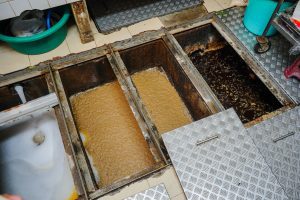Congratulations! Business at your new restaurant is booming and you’ve gotten rave reviews about the food and ambiance. But have you thought about how to best clean your grease traps? This can be one of the most overlooked items new restaurant owners don’t consider when opening a new establishment. Fortunately, companies like SeQuential are available to help. We offer an all-in-one grease trap cleaning and used cooking oil recycling service so that you can focus on the more exciting aspects of running your restaurant. You’ll also have the added benefit of helping the environment since we take the used cooking oil and turns it into renewable fuel. Here, we go over everything new restaurant owners need to know about cleaning grease traps and recycling used cooking oil.
What Is a Grease Trap?
The name may not be pretty, but grease traps are a necessary component in the kitchen of any school, hospital, restaurant, or commercial dining facility that prepares a high volume of food and meals. A grease trap is attached to the kitchen’s plumbing fixture to trap and contain the incidental food, oil, and grease (FOG) that has been flushed down the sink.
This trap intercepts FOG, preventing this mixture from entering the sewage system and reducing the hazards of clogging or damaging sewage lines. It also eliminates bacteria and keeps foul odors from lingering in the kitchen. In nearly all states across the country, large-scale kitchens are legally required to install and operate a grease trap.
Grease Trap Cleaning
To operate effectively, grease traps must undergo regular cleanings. Disinfecting this equipment involves the following steps:
- First, slowly remove the trap lid, taking care not to damage any of the gaskets located just under the cap.
- Draw and diagram the trap’s parts and where they go so you can put it back together and install it once clean.
- Insert a wooden stick into the liquid so the FOG marks the wood and then remove the stick.
- On the stick, measure the inches of accumulated FOG that were marked and record this on the appropriate United States Environmental Protection Agency (EPA) forms.
- Drain the water in the trap container, then remove and properly dispose of the grease and debris.
- Using copious amounts of soap and water to clean and disinfect trap parts.
- Reassemble and replace the grease trap.
Just to clean your grease trap is a rather laborious process that most people would consider unpleasant. You could also have a big mess on your hands and face trouble with legal and local health departments if you don’t follow the correct procedure with grease disposal and maintenance.
This is where the grease cleaning and recycling experts at SeQuential come in. We know you’re busy, so we are happy to clean your grease trap. Our services allow you to focus on your top priority of providing a unique and delicious dining experience for your guests.
Benefits of SeQuential Grease Trap Cleaning and Grease Recycling
At SeQuential, we strive to exceed the expectations of our clients when delivering grease trap services. We take on the following tasks to alleviate your concerns about grease trap maintenance:
- Schedule regular cleanings that adhere to local FOG regulations and enforcement
- Keep expenses under control while ensuring your staff members focus on their most important duties, such as customer service
- After we clean your grease trap, we take care of the government-required FOG paperwork
Another advantage of our services is that we provide clients with peace of mind. You can trust that your FOG waste is properly recycled and goes toward helping the local environment and economy.
SeQuential is focused on making the most renewable fuel. We only refine waste cooking oil and grease from restaurants and commercial kitchens like yours, not from crop feedstock. This approach eliminates FOG from landfills and waterways and transforms what was once waste into renewable fuel that emits significantly less carbon dioxide than conventional fuel. Relying on grease recycling to make renewable fuel also reduces the need to employ fresh grains.
Learn How SeQuential Can Recycle Your Kitchen’s Grease
For nearly two decades, SeQuential has been in the grease recycling business. We work with commercial kitchens and restaurants along the West Coast and throughout the country by collecting used cooking oil. Which is then turned into renewable fuel by our parent company. Contact us today to learn more about our grease recycling services.
